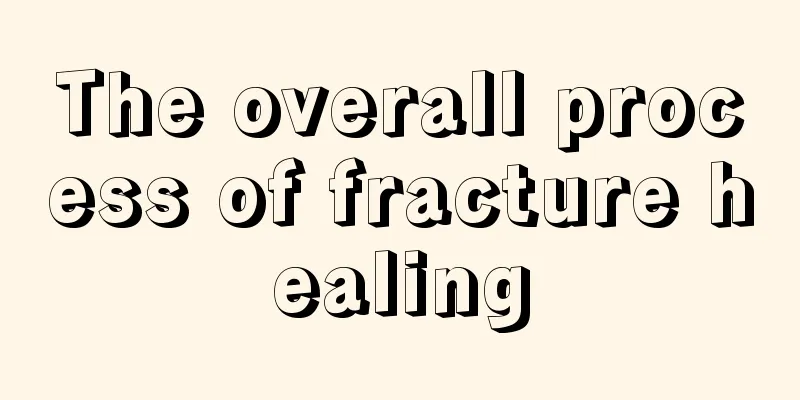The overall process of fracture healing

|
I believe that every sports enthusiast knows the importance of human bones to the body. In our daily lives, bone injuries may sometimes occur, such as fractures. This requires us to have a certain understanding of fractures. If a fracture occurs, how can we take protective measures for fracture healing? Let us now understand the fracture healing process. Fracture healing stages 1. Impact period The time from the moment the force is applied to the moment the energy is eliminated is short. The degree of injury to bones and surrounding soft tissues is closely related to the amount of energy absorbed. The higher the energy and the higher the speed of injury, the more severe the fracture. (II) Induction period The main manifestations are hematoma formation, necrosis of bone cells at the fracture ends, damaged periosteum and surrounding cells. After a fracture, the bone's nutrient arteries and their branches and surrounding muscles are torn. There are varying degrees of bleeding, the severity of which is related to the fracture type, bone volume, anatomical location, and amount of displacement. Bleeding may extravasate to form a hematoma in the surrounding area. The amount of bleeding is often underestimated. In severe cases, such as long bones and pelvis, it may cause hypovolemic traumatic shock. After the cells at the fracture ends die, the oxygen partial pressure in the hematoma decreases. Acidity increases. The local area contains kinins, prostaglandins and non-collagen proteins, and releases a variety of cytokines. (III) Inflammatory phase It begins early after injury and continues until chondrocytes and osteocytes appear. The local inflammatory response is manifested by vasodilation, plasma exudation, edema and infiltration of inflammatory cells, including neutrophils, mast cells and macrophages, and osteoclasts begin to clear dead bone. The fibrin network in the hematoma is invaded by new blood vessels. Along with the invasion of blood vessels, a large number of mesenchymal cells proliferate around it and differentiate into fibroblasts and macrophages. As the red blood cells in the hematoma are destroyed and fibrin exudes, the hematoma is gradually cleared and replaced by a loose network of fibrin, reticular fibrils and collagen fibers, which quickly organize into granulation tissue and then form fibrous osteoid. (IV) Cartilage madness stage The hematoma has become organized, the fracture ends are filled with cellular components, and there are obvious new blood vessels. Osteoclasts continue to clear the remaining dead bone. New bone is formed under the periosteum near the fracture ends, and chondrocytes begin to appear in the gap between the fracture ends, replacing the fibrovascular stroma with cartilage-like tissue. (V) Hard callus stage After a fracture, the periosteum and endosteum near the broken ends begin to proliferate and thicken. There is also blood vessel invasion, and bone is formed by intramembranous ossification. On the other hand, between the fracture ends and under the lifted periosteum, most of the fibrovascular granulation tissue formed by the organization of the hematoma is transformed into cartilage, and bone is formed by endochondral ossification. Chondrocytes form bone through proliferation, hypertrophy, degeneration, and ossification. 6. Shaping and Reconstruction Period Regenerated bone is constantly remodeled according to mechanical principles and the needs of the human body. That is, osteoclasts are constantly absorbing and osteoblasts are forming new bone. If the fracture is well aligned, the fracture site can be completely restored to its original shape, the medullary cavity can be unobstructed again, and no trace of fracture will be left. Even if there is slight migration and angular deformity, it can be completely corrected, especially in children and adolescent patients. The defect on the concave side can be supplemented by intramembranous ossification, and the excess bone on the convex side is absorbed to adapt to the local load. However, this reconstruction has its limits, and severe deformities will be difficult to completely correct. The above introduces us to several processes of fracture healing. The fracture healing process needs to go through six stages. I believe that everyone has a certain understanding of it and is no longer unfamiliar with the fracture healing process. It will also be of certain help to our future life, health and exercise. |
<<: What is the length of the rectum?
>>: Surgical methods for turbinate hypertrophy surgery
Recommend
What are the dangers of lung cancer
When people hear about lung cancer, they will fee...
Do you know what the staging criteria for gallbladder cancer are?
Gallbladder cancer is one of the malignant tumors...
What is the use of dried henna
Henna is a flower that is somewhat similar to hum...
Is there any relationship between heavy menstrual flow and uterine cancer?
Menstruation is the most basic indicator of a wom...
Distant metastasis of breast cancer is the main cause of death!
Breast cancer is increasingly threatening the hea...
What are the common methods to prevent ovarian tumors
The factors that cause ovarian tumors are still u...
How to wash off oil stains on clothes
For female friends, getting oil stains on a beaut...
What type of cancer is cavitary lung cancer?
What type of cancer is cavitary lung cancer? 1. C...
I didn't bring any makeup remover, what can I use instead?
For female friends, after putting on makeup, it i...
Milk plus salt has such a magical effect
Milk is a beverage we drink every day. It has the...
What are the reasons for repeated facial allergies?
Recurrent facial allergies are also quite common....
We need to analyze the causes of liver cancer from various angles
With the development of science and technology, t...
What to do without eyelashes
Everyone wants to have a pair of big, bright eyes...
What to do about nephrotic syndrome?
Many people will become very nervous, panic and e...
How to stay away from stomach cancer
The occurrence of gastric cancer is the result of...









